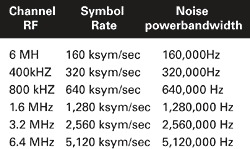Digitally Modulated Carrier CNR
We have, for as long as I can remember, been concerned with carrier-to-noise ratio (C/N or CNR) in our networks. CNR, in cable industry vernacular, is a pre-detection measurement—that is, a measurement made in the frequency domain. By definition, CNR is the difference, in decibels, between the amplitude of an RF signal and the amplitude of noise present in the RF signal’s transmission path. The RF signal may be unmodulated (continuous wave or CW) or modulated, and is the “C” in CNR. The noise may be one of several types: thermal noise, shot noise, relative intensity noise (RIN), and in systems carrying a mix of analog TV channels and digitally modulated carriers, nonthermal noise such as composite and intermodulation noise. I’m going to focus on thermal noise generated by passive and active devices through which the RF signal is transmitted. The amplitude of thermal noise—also known as additive white Gaussian noise or AWGN—usually is specified over a certain bandwidth called noise power bandwidth. The “N” in CNR is the thermal noise’s root mean square (rms) amplitude. In the world of analog TV signals, the “C” in CNR refers to the amplitude of a TV channel’s visual carrier, which is defined as the rms amplitude of the instantaneous synchronizing peak. “N”, of course, is the noise floor of the device or network through which the TV channel is transmitted. Noise power bandwidth for National Television System Committee (NTSC) channels is 4 MHz, and Federal Communications Commission rules for cable specify a minimum CNR of 43 dB at the subscriber terminal. So far so good. What about digitally modulated carriers? While there is no FCC rule defining minimum CNR for digitally modulated carriers, the Data Over Cable Service Interface Specification (DOCSIS) Radio Frequency Interface Specification does include an assumed downstream RF channel transmission characteristic for CNR: not less than 35 dB. The DOCSIS upstream spec is 25 dB. Digitally modulated carrier amplitude is defined as the signal’s average power, sometimes called digital channel power. Many of today’s signal level meters, quadrature amplitude modulation (QAM) analyzers and even some spectrum analyzers include an automated downstream digital channel power measurement function. I encourage you to use test equipment that performs automated downstream digital channel power measurements, rather than trying to make error-prone manual measurements that require bandwidth, intermediate frequency (IF) or resolution bandwidth (RBW) filter, log amplifier and detector corrections.
Upstream digitally modulated carrier average power is a bit more challenging because of the signal’s bursty nature. One accurate way to measure a cable modem’s upstream digitally modulated carrier is to use a spectrum analyzer that supports zero-span measurement of the preamble amplitude, which equals the signal’s average power. Mark Millet and I co-authored an article about this a few years ago (“Upstream Power Measurements: Watts Up Doc?”, December 2000 Communications Technology, www.broadband-pbimedia.com/archives/ct/1200/064_upstream.htm). What not to do One way that you shouldn’t measure an upstream digitally modulated carrier’s average power is with a spectrum analyzer’s max hold function. If everything is working correctly, it may get you close, but here’s an example of where max hold can go wrong. Let’s say one of your modems is transmitting 10 dB hot. When you use a spectrum analyzer’s max hold function, what does the display show? That’s right—the highest signal! So, in our hypothetical example, the displayed amplitude would be 10 dB too high because of the one broken modem. Use the zero-span method instead. OK, you’ve measured the digitally modulated carrier’s average power. This is the “C” in CNR. The “N” part of CNR is pretty straightforward. Find a clean part of the spectrum—hopefully not too far from the digitally modulated carrier—and measure the system noise floor amplitude with, say, a spectrum analyzer. Before getting too far into this procedure, make certain you’re measuring the system noise floor and not the analyzer’s noise floor. Temporarily disconnect the spectrum analyzer’s RF input. The displayed noise floor should drop at least 10 dB. If it doesn’t, you’re measuring test equipment noise. You can apply a noise-near-noise correction when the noise drops less than 10 dB, or you can reduce the input attenuation or connect the analyzer to a hotter test point. After you measure the system noise floor, you invariably will have to correct the measurement result from the analyzer’s RBW setting to a noise power bandwidth suitable for the digitally modulated carrier. That noise power bandwidth is not the same 4 MHz you use for analog NTSC TV channels! Making a digitally modulated carrier CNR measurement relative to 4 MHz noise power bandwidth does not equate the result to your analog TV channel CNR numbers. It’s best to use a noise power bandwidth equal to the digitally modulated carrier’s symbol rate. The table summarizes channel bandwidths, symbol rates and noise power bandwidths applicable to DOCSIS and Euro-DOCSIS digitally modulated carriers. For example, if you were measuring CNR for a 6 MHz bandwidth 64-QAM downstream digitally modulated carrier, you first would measure its average power. Next, you’d measure the system noise floor amplitude, then correct that measurement result to a noise power bandwidth of 5.06 MHz (5,056,941 Hz). The difference between the corrected noise reading and the digitally modulated carrier’s average power is the CNR. Be sure to take into account any other noise measurement corrections such as filter shape and log amp factors, if applicable to the test equipment being used. Finally, the result you get will most likely include not only thermal noise, but also composite and intermodulation noise, and if a fiber link is in the mix, shot noise and RIN. Ron Hranac is a technical leader, Broadband Network Engineering for Cisco Systems, and senior technology editor for Communications Technology. Reach him at rhranac@aol.com. Table 